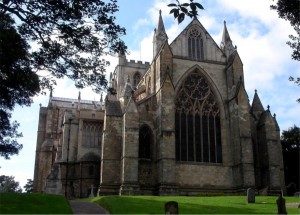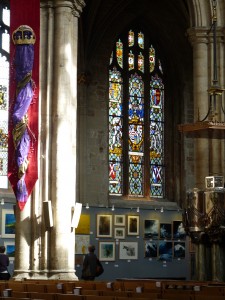Since Great North Art Show began, it has been based in the spectacular setting of Ripon Cathedral.
But as well as being a stunning example of almost every period of architecture from the 7th to the 16th centuries, Ripon Cathedral has a fascinating 1300-year history.

But how and when was the cathedral established?
To this find out, we need to go back in time to the early medieval period, when Rome was still part of the Byzantine Empire, Venice was an independent realm of fishing villages built by fugitives, and the Mayans were building the Temple of Inscriptions in Mexico.
Back here in Northern England, a boy was born who was to eventually found the original Ripon Cathedral. A boy who would in time become a saint.
Wilfrid was born into a Northumbrian aristocrat family around 633AD.
In his teens, Wilfrid entered religious life. He studied at the famous Lindisfarne (also known as Holy Island), the site of the earliest Christian monastery in Anglo-Saxon Northumbria.
Incidentally, the monks of Lindisfarne were pivotal in the history of the English language. They are credited with the emergence and spread of the first form of written English, when they translated their Lindisfarne Gospels from the traditional written Latin language (brought over by the Romans) into the medieval English language spoken by the people.
After going away to study in Canterbury, Gaul and Rome, Wilfrid returned to Northumbria in about 660, and became the abbot of a newly founded monastery at Ripon.
So how did this young man returning home after his studies become such an influential (and at times controversial) figure?
Wilfrid: an influential and controversial English saint?
Wilfrid is described by EnglishChurchArchitecture.net as someone who “impressed his contemporaries more by his haughty, uncompromising temperament than his ascetic, contemplative life: he was an ambitious, stubborn and difficult man yet also, it must be said, energetic and scrupulous about pursuing what he considered the right course - regardless, indeed, not only of whether others agreed with him but even of the consequences to himself.”
In 664, Wilfrid acted as spokesman for the Roman position at the Synod of Whitby. He is now famous for his speech advocating that the Roman method for calculating the date of Easter should be adopted. This was a matter of deep religious significance, resulting in the then Bishop Colman of Northumbria returning disappointed. When the Bishop’s replacement died soon after, the king’s son, Alhfrith – impressed by Wilfrid’s speech – appointed him the new Bishop of Northumbria.
Wilfrid promptly transferred the see (the official seat of a bishop, located in a particular church) from Lindisfarne to York. He then claimed there was nobody in England able to consecrate him and he needed to travel to Gaul for the ceremony. His rather leisurely trip ended up lasting two years, during which time King Oswiu had tired of waiting for him and appointed St Chad in his place.
Wilfrid returned to Ripon and remained there until 669, when Theodore, the newly appointed Archbishop of Canterbury, deposed Chad and restored Wilfrid.
The building of the first great stone church at Ripon
Wilfrid wasted no time in replacing the old timber church at Ripon Monastery with a Roman-style stone church in 672. Pioneering, it was one of the earliest stone buildings erected in the Anglo-Saxon Kingdom of Northumbria.
Wilfrid brought stonemasons, plasterers and glaziers from France and Italy to build his great basilica. A companion of Wilfrid’s known as Eddius Stephanus observed that “in Ripon, Saint Wilfrid built and completed from the foundations to the roof a church of dressed stone, supported by various columns and side-aisles to a great height and many windows, arched vaults and a winding cloister.”
EnglishChurchArchitecture.net describes how “this success too was short-lived, for after Oswiu’s death the following year, Wilfrid soon fell foul of Ecgfrith his successor, first by encouraging his queen, Aethelthryth, to continue in her virginity after her marriage and, later, to enter a monastery, and then, after Ecgfrith had divorced her and remarried, by also managing to antagonize his new queen.”
Over the next few years, Archbishop Theodore (his patience tested by Wilfrid’s ability to upset people in high places) split Wilfrid’s diocese into smaller units, appointing new bishops to York, Lindisfarne, Hexham and Ripon. This was a critical moment, as it raised the status of the monastic church at Ripon to that of a cathedral for the first time.
The church becomes a cathedral at Ripon
The Ripon Cathedral you see today is the forth to stand on this site. It became a cathedral of the (then) newly created Anglican Diocese of Ripon in 1836.
When Wilfrid died, he was canonised (admitted into the canon of saints), becoming Saint Wilfrid.
It is no surprise that this important building, which (we will explain in a later blog post) has had such a fascinating and varied history, should now be the venue for the exciting collection of contemporary art at Great North Art Show.
Saint Wilfrid was buried in this church near the high altar.
The ancient Saxon crypt he built is the only part of his original church to have survived intact since 672 – making it arguably the oldest church building in England to have remained in continuous use. Visitors still come from near and far, as they have done since the 7th century, to offer prayers in Saint Wilfrid’s crypt.
You can visit his crypt in Ripon Cathedral during the exhibition.
Find out more about:
- The history of Great North Art Show
- Great North Art Show 2014 Prize
- Great North Art Show Art Trail
- Ripon Cathedral




